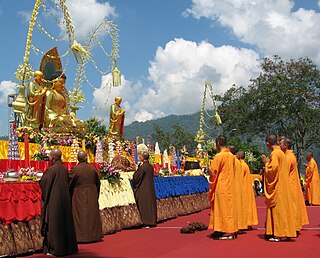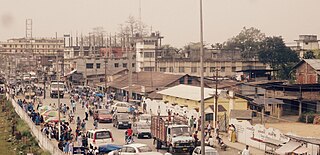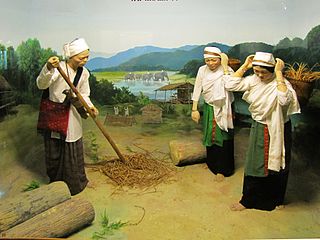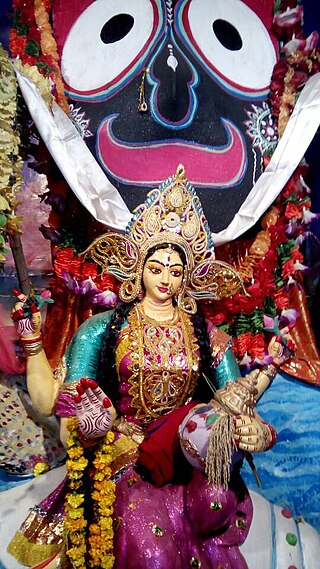
Vesak, also known as Buddha Jayanti, Buddha Purnima, Buddha Day, is a holiday traditionally observed by Buddhists in South Asia and Southeast Asia, as well as Tibet and Mongolia. It is the most important Buddhist festival. The festival commemorates the birth, enlightenment (Nibbāna), and passing (Parinirvāna) of Gautama Buddha in Theravada, Tibetan Buddhism and Navayana.

Thai New Year or Songkran, also known as Songkran Splendours, is the Thai New Year's national holiday. Songkran is on 13 April every year, but the holiday period extends from 14 to 15 April. In 2018 the Thai cabinet extended the festival nationwide to seven days, 9–16 April, to enable citizens to travel home for the holiday. In 2019, the holiday was observed 9–16 April as 13 April fell on a Saturday. The word "Songkran" comes from the Sanskrit word saṃkrānti, literally "astrological passage", meaning transformation or change. It coincides with the rising of Aries on the astrological chart and with the New Year of many calendars of Southeast and South Asia, in keeping with the Buddhist and Hindu Calendar. The New Year takes place at around the same time as the new year celebrations of many regions of South Asia like China, India, Laos, Cambodia, Myanmar, Nepal, and Sri Lanka.

The Dai people are several Tai-speaking ethnic groups living in the Xishuangbanna Dai Autonomous Prefecture and the Dehong Dai and Jingpo Autonomous Prefecture of China's Yunnan Province. The Dai people form one of the 56 ethnic groups officially recognized by the People's Republic of China. By extension, the term can apply to groups in Laos, Vietnam, Thailand and Myanmar when Dai is used to mean specifically Tai Yai, Lue, Chinese Shan, Tai Dam, Tai Khao or even Tai in general. For other names, see the table below.

Makar(a) Sankranti, also referred to as Uttarayana, Makar, or simply Sankranti, is a Hindu observance and a festival. Usually falling on the date of 14 January annually, this occasion marks the transition of the sun from the zodiac of Sagittarius (dhanu) to Capricorn (makara). Since the sun has made this transition which vaguely coincides with moving from south to north, the festival is dedicated to the solar deity, Surya, and is observed to mark a new beginning. Many native multi-day festivals are organised on this occasion all over India.

Vishu is a Hindu festival celebrating the Malayali New Year in Kerala, Tulu Nadu, and Mahe of India. Vishu falls on the first day of the month of Medam in the Malayalam Calendar. It is the traditional new year, while the Kollam era calendar new year falls on the 1st Chingham.

Buddha's Birthday or Buddha Day is a primarily Buddhist festival that is celebrated in most of South, Southeast and East Asia, commemorating the birth of the prince Siddhartha Gautama, who became the Gautama Buddha and founded Buddhism. According to Buddhist tradition and archaeologists, Gautama Buddha, c. 563-483 BCE, was born at Lumbini in Nepal. Buddha's mother was Queen Maya Devi, who delivered the Buddha while undertaking a journey to her native home, and his father was King Śuddhodana. The Mayadevi Temple, its gardens, and an Ashoka Pillar dating from 249 BCE mark the Buddha's birth place at Lumbini.

The Water Festival is the New Year's celebrations that take place in Xishuangbanna (China) and Southeast Asian nations such as Thailand, Laos, Myanmar, and Cambodia as well as among the Dai people of China, and the southern parts of Vietnam. It is part of the broader South and Southeast Asian solar New Year. It is called the 'Water Festival' by Westerners because they notice people splashing or pouring water at one another as part of the cleansing ritual to welcome the Songkran New Year. Traditionally, people gently sprinkled water on one another as a sign of respect, but as the new year falls during the hottest month in South East Asia, many people end up dousing strangers and passers-by in vehicles in boisterous celebration. The act of pouring water is also a show of blessings and good wishes. It is believed that at this Water Festival, everything old must be thrown away, or it will bring the owner bad luck.

The Khamyang (Tai-Khamyangs or Shyam), is a subgroup of the Tai peoples of Southeast Asia. They are numerically a small indigenous group found in Tinsukia, Jorhat, Sivasagar and Golaghat districts of Assam, and adjacent parts of Arunachal Pradesh. Their population totals about 7,000, of which only a small minority speak the native Tai Khamyang language while the vast majority speak the Assamese language. The Khamyang are followers of Theravada Buddhism and are closely related to the Khamti. They maintain good relations with other Tai Buddhist tribes of Assam.
Tai Phake, also known as Phakial or simply Phake, belong to the Tai-speaking indigenous ethnic group living in Dibrugarh district and Tinsukia district of Assam, principally along the areas of Dihing river as well as adjacent parts of Lohit and Changlang district in Arunachal Pradesh. As of 1990, their population stood at 5,000, which consists of less than 250 families.

Naharkatia is a town and a Municipal board in Dibrugarh district in the Indian state of Assam. It is well known for petroleum and gas reserves. Earlier, Duliajan, the head office town of Oil India Limited was in its circle. However, the towns are close, within a 30-minute journey.

Sinhalese New Year, generally known as Aluth Avurudda in Sri Lanka, is a Sri Lankan holiday that celebrates the traditional New Year of the Sinhalese people and Tamil population of Sri Lanka. It is a major anniversary celebrated by not only the Sinhalese and Tamil people but by most Sri Lankans. The timing of the Sinhala Tamil New Year coincides with the new year celebrations of many traditional calendars of South and Southeast Asia. The festival has close semblance to the Tamil New year and other South and Southeast Asian New Years. It is a public holiday in Sri Lanka. It is generally celebrated on 13 April or 14 April and traditionally begins at the sighting of the new moon.

The Tai Khamti, also known as the Hkamti Shan or simply as Khamti, are a Tai ethnic group of India, China and Myanmar. The Tai-Khamti are followers of Theravada Buddhism. The Tai-Khamti have their own script for their language, known as 'Lik Tai', which originated from the Shan (Tai) script of Myanmar. Their mother tongue is known as Khamti language. It is a Tai language, closely related to Thai and Lao.

Magh Bihu (also called Bhogali Bihu or Maghar Domahi is a harvest festival celebrated in Assam, North-East India, which marks the end of harvesting season in the month of Magh. A bonfire is lit for the ceremonial conclusion and prayer to the God of Fire. The festival is a regional variance of Makar Sankranti.

Lakshmi Puja is a Hindu occasion for the veneration of Lakshmi, the goddess of prosperity and the supreme goddess of Vaishnavism. The occasion is celebrated on the amavasya in the Vikram Samvat Hindu calendar month of Ashwayuja or Kartika, on the third day of Deepavali (Tihar) in most part of India and Nepal. In Assam, Bengal, and Odisha, this puja is celebrated five days after Vijaya Dashami.
Tokha Chandeshwari is a village and former Village Development Committee that is now part of Tokha Municipality in Kathmandu District in Province No. 3 of central Nepal. At the time of the 2011 Nepal census it had a population of 3,961. Tokha Chandeshwari now is part of Tokha municipality.

Pana Sankranti,, also known as Maha Bishuba Sankranti, is the traditional new year day festival of Odia people in Odisha, India. The festival occurs in the solar Odia calendar on the first day of the traditional solar month of Meṣa, hence equivalent lunar month Baisakha. This falls on the Purnimanta system of the Indian Hindu calendar. It therefore falls on 13/14 April every year on the Gregorian calendar.

Songkran is the water festival celebration of traditional new year for Buddhist calendar widely celebrated across South and Southeast Asia in Bangladesh, Cambodia, Laos, Myanmar, Sri Lanka, Thailand, parts of northeast India, parts of Vietnam and Xishuangbanna, China begins on 13th April of the year.
Here is a list of glossary of Culture of India in alphabetical order:
The traditional New Year in many South and Southeast Asian cultures is based on the sun's entry into the constellation Aries. In modern times, it is usually reckoned around 14 April.














